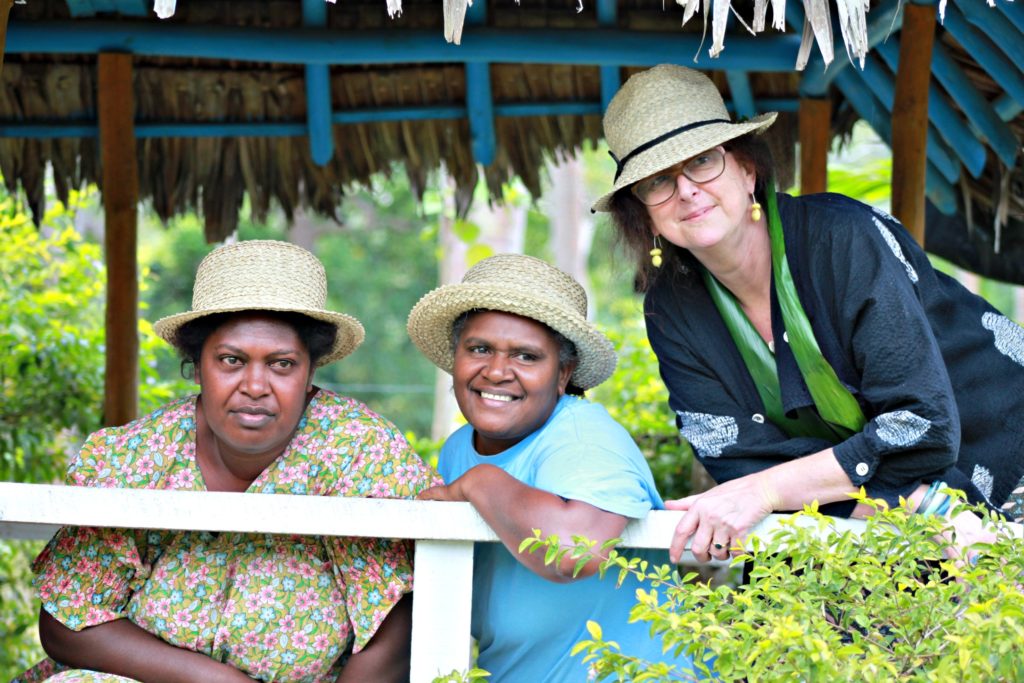Travel
Hats Off to Vanuatu, Weavers take on the World
Millinery magic with a royal twist. The Pacific Brim success story. By Alex Bortoli.
September 2, 2019
Rebecca Murphy
September 2, 2019Everyone loves a ‘feel good’ story. And this is up there with the best of them. In fact, if it wasn’t true, you’d be hard pressed to make up such an unlikely but perfect confluence of events. So how exactly did a group of traditional women weavers in Vanuatu link up with an internationally renowned hat maker to create a brand of Vanuatu hats now being exported throughout the world?
Essentially, this is a modern day fairy tale with a royal twist, thanks to Prince Charles purchasing a beautifully woven pandanus hat for his wife Camilla to wear during their recent visit to Vanuatu. But more on this later.

The story begins in 2015, when Australian milliner, Rosie Boylan, visits the island of Espiritu Santo and connects with local weavers from the islands of Malo and Espiritu Santo.
She is stunned by the weaving expertise of the women, who are adept at making bags, baskets and mats from coconut and pandanus leaves and who have inherited their skills as part of a rich and living culture spanning thousands of years of Vanuatu history.
Now keep in mind Boylan is no ordinary hat maker. In addition to being a highly respected craftswomen with 35 years’ experience in the industry, her bespoke hats have featured in several Hollywood movies, including Moulin Rouge, Australia, The Piano, Peter Pan and The Great Gatsby, as well as in major theatre productions like The King and I, Phantom of the Opera and Love Never Dies. Cate Blanchett is a fan (which is interesting, as Cate is also a well known Vanuatu investor and supporter!).
Boylan immediately recognises the potential for creating a new craft hub in Santo and the women bond out of a mutual respect for their craft. They begin exploring the possibilities of translating their weaving skills into making quality headwear for a global market.
As luck would have it, the group attracts the attention the Sanma Skills Centre, run by the Vanuatu Ministry of Education and Training and supported by the Australian Government through the Vanuatu Skills Partnership. They engage Boylan as one of their industry coaches.
Working as a team with respected community leader, Janet Sine, the duo develop new hat making tools, purchase specialised hat-making equipment and begin to train and coach the women in hat weaving. They quickly take the group’s skills and production output to a whole new level, and under Boylan’s Pacific Brim label, the hats are further enhanced with quality finishings designed to appeal to an international market.
And here’s where the fairy tale aspect comes into it. Because you see, even with the best of intentions and a feel good story woven into every hat, sometimes political, cultural and economic interests intervene to unravel the potential of a wonderful project. But not this time.
This time the stars align and Sanma style hats begin spreading their brims beyond the island’s borders, first to local shops and then overseas. This is thanks, in no small part, to the Vanuatu Government’s commitment to promoting a ‘Made in Vanuatu’ brand and Boylan’s extensive expertise and industry connections.

In fact, Vanuatu’s Sanma-style hats can now be found in shops as far away as Japan and New Zealand and gracing the windows of prestigious hat stores in Sydney’s Strand Arcade as well as in Newtown. Custom made options are also being sought after by bespoke clients peppered throughout the world via Pacific Brim’s on-line shop.
Best of all, in true fairy tale style, the success of the project both overseas and locally is having a magical, transformative effect back on Santo. The women’s groups are becoming increasingly confident in both their weaving and business skills. They are discovering economic empowerment and spreading the message throughout their communities that locally made handicrafts have value and can be both sustainable and profitable.
As for Rosie Boylan, she is over the moon with the progress of the Skills Centre ‘Sanma-style’ hat hub.
“This story is not about me. It’s about the local weavers, their cultural heritage and the remarkable network that is supporting and empowering them. Our vision is for the women to own their own businesses and ultimately be selling their handicrafts locally, nationally and internationally with fair trade principles in place.”
Which brings us back to that beautiful hat Prince Charles buys Camilla, the Duchess of Cornwall, during their visit to Vanuatu in April 2018. The hat is a product of another women’s group mentored by Boylan and based in Port Vila (appropriately called WEAV).
And sure, in the perfect fairy tale ending a hat would be worn by a princess and it would save her from a fate worse than death (or perhaps help her catch the eye of her one true love). But in the real world a Prince and a Duchess helping to promote sustainability and empowerment in a tiny Pacific island nation is as close to a happy ending as you can get!
© 2024 Pacific Island Living Magazine all Rights Reserved
Website by Power Marketing